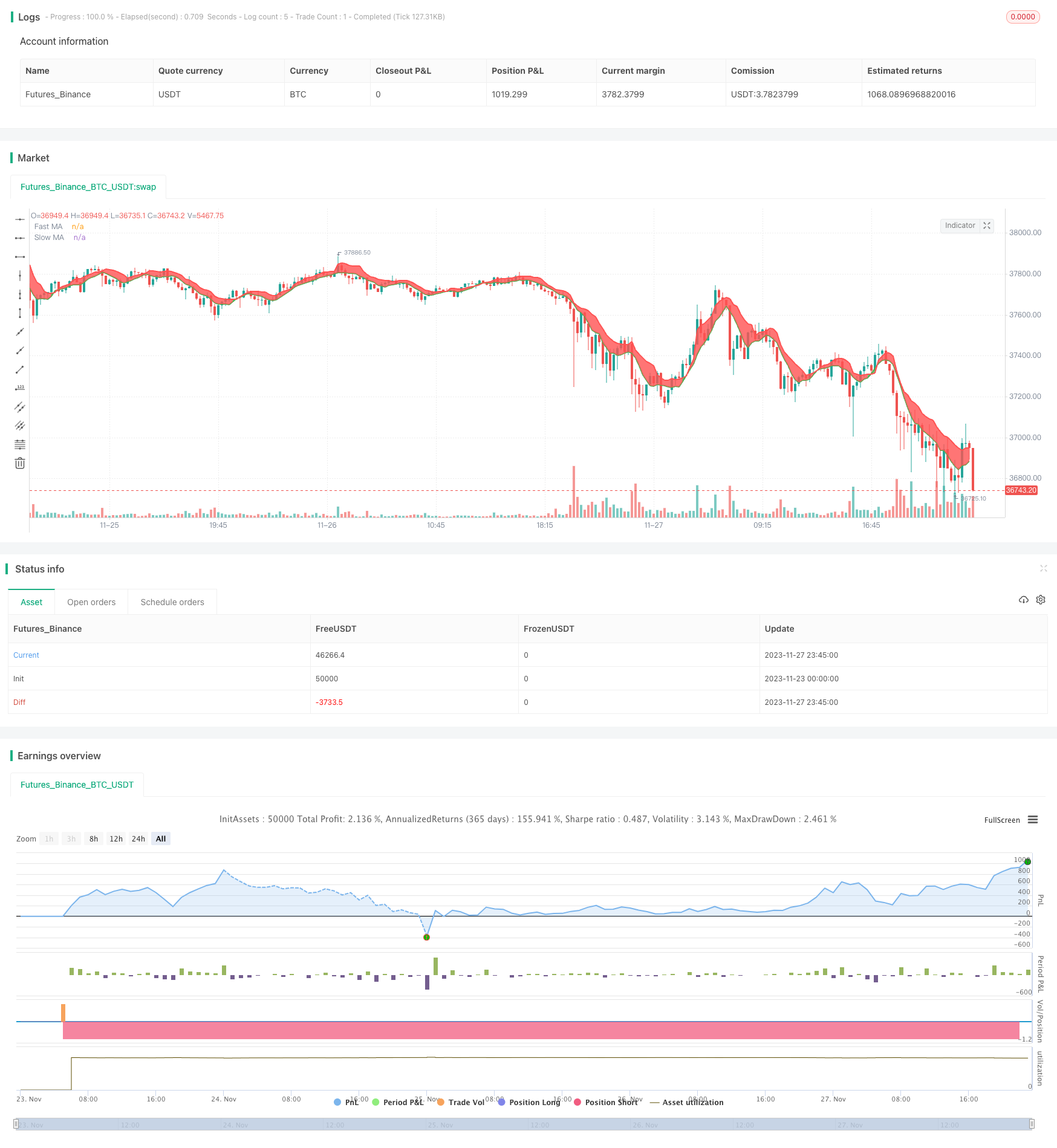
概述
该策略是基于双重均线交叉的趋势跟踪策略。它结合了快速简单移动平均线(SMA)和缓慢加权移动平均线(VWMA),利用两条平均线的交叉形成买入和卖出信号。
当快速SMA向上穿过缓慢VWMA时,产生买入信号;当快速SMA向下穿过缓慢VWMA时,产生卖出信号。策略采用止损机制控制风险。
策略原理
该策略的核心逻辑基于双重均线交叉系统。具体来说,它同时运用了以下技术指标:
- 简单移动平均线(SMA):对最近n天的收盘价取算术平均值,能反映最近期间的平均价格。
- 加权移动平均线(VWMA):对最近n天的收盘价进行加权平均,赋予近期价格更大权重,能更快速地响应价格变动。
双重均线中的快速SMA参数设置较短,能快速响应价格变化;缓慢VWMA参数较长,具有滤波作用。当短期和长期趋势向同一方向发展时,快速SMA向上穿越缓慢VWMA产生买入信号;向下穿越时产生卖出信号。
该策略同时设置止损机制。当价格向不利方向运行时,及时止损以控制风险。
优势分析
- 响应迅速,跟踪市场趋势的变化
- 回撤控制好,止损机制有效控制风险
- 简单直观,容易理解实现
- 可以通过调整参数进行优化,适应不同市场环境
风险分析
- 双重均线策略容易产生多头市场的假信号
- 需要选择合适的参数,不当设置可能导致亏损
- 偶尔可能会头疼 Markt 的突发事件而造成损失
风险控制的方法:
- 采用趋势过滤指标进行确认
- 优化参数设置
- 采取止损策略,合理控制单笔损失
优化方向
该策略可以从以下几个方面进行优化:
- 结合其他技术指标进行确认,例如RSI,布林线等,提高信号的准确性
- 优化均线参数的长度,根据不同周期调整参数
- 结合交易量指标,在大量能量进出的点位进行交易
- 根据回测结果进行参数调整,选择最优参数
- 采用动态止损,根据市场波动程度来调整止损点
总结
该策略整体来说是一个非常实用的趋势跟踪策略。它采用简单直观的双重均线交叉来产生交易信号,通过快速均线和缓慢均线的配合,能够有效捕捉市场趋势的变化。止损机制也使其具有良好的风险控制。通过配合其他指标和参数优化,可以进一步提高策略的交易效果。
策略源码
/*backtest
start: 2023-11-23 00:00:00
end: 2023-11-28 00:00:00
period: 15m
basePeriod: 5m
exchanges: [{"eid":"Futures_Binance","currency":"BTC_USDT"}]
*/
//@version=4
//strategy(title="Bitlinc Entry v0.1 VWMA / SMA / MRSI SQQQ 94M", overlay=true, initial_capital=10000, currency='USD')
strategy(title="Bitlinc Entry v0.1 VWMA / SMA / MRSI SQQQ 94M", overlay=true)
// Credit goes to this developer for the "Date Range Code"
// https://www.tradingview.com/script/62hUcP6O-How-To-Set-Backtest-Date-Range/
// === GENERAL INPUTS ===
// short ma
maFastSource = input(defval = close, title = "Simple MA Source")
maFastLength = input(defval = 6, title = "Simple MA Length", minval = 1)
// long ma
maSlowSource = input(defval = high, title = "VW MA Source")
maSlowLength = input(defval = 7, title = "VW MA Period", minval = 1)
// === SERIES SETUP ===
// a couple of ma's...
maFast = sma(maFastSource, maFastLength)
maSlow = vwma(maSlowSource, maSlowLength)
// === PLOTTING ===
fast = plot(maFast, title = "Fast MA", color = color.green, linewidth = 2, style = plot.style_line, transp = 30)
slow = plot(maSlow, title = "Slow MA", color = color.red, linewidth = 2, style = plot.style_line, transp = 30)
// === INPUT BACKTEST RANGE ===
FromMonth = input(defval = 1, title = "From Month", minval = 1, maxval = 12)
FromDay = input(defval = 1, title = "From Day", minval = 1, maxval = 31)
FromYear = input(defval = 2018, title = "From Year", minval = 2017)
ToMonth = input(defval = 1, title = "To Month", minval = 1, maxval = 12)
ToDay = input(defval = 1, title = "To Day", minval = 1, maxval = 31)
ToYear = input(defval = 9999, title = "To Year", minval = 2017)
// === FUNCTION EXAMPLE ===
start = timestamp(FromYear, FromMonth, FromDay, 00, 00) // backtest start window
finish = timestamp(ToYear, ToMonth, ToDay, 23, 59) // backtest finish window
window() => time >= start and time <= finish ? true : false // create function "within window of time"
// === LOGIC ===
enterLong = crossover(maFast, maSlow)
exitLong = crossover(maSlow, maFast)
//enterLong = crossover(maSlow, maFast)
//exitLong = crossover(maFast, maSlow)
// Entry //
strategy.entry(id="Long Entry", long=true, when=window() and enterLong)
strategy.entry(id="Short Entry", long=false, when=window() and exitLong)
// === FILL ====
fill(fast, slow, color = maFast > maSlow ? color.green : color.red)
// === MRSI ===
//
//
basis = rsi(close, input(50))
ma1 = ema(basis, input(2))
ma2 = ema(basis, input(27))
oversold = input(32.6)
overbought = input(63)
//plot(ma1, title="RSI EMA1", color=blue)
//plot(ma2, title="RSI EMA2", color=yellow)
obhist = ma1 >= overbought ? ma1 : overbought
oshist = ma1 <= oversold ? ma1 : oversold
//plot(obhist, title="Overbought Highligth", style=columns, color=color.maroon, histbase=overbought)
//plot(oshist, title="Oversold Highligth", style=columns, color=color.yellow, histbase=oversold)
//i1 = hline(oversold, title="Oversold Level", color=white)
//i2 = hline(overbought, title="Overbought Level", color=white)
//fill(i1, i2, color=olive, transp=100)
// === LOGIC ===
enterLongMrsi = crossover(ma1, oversold)
exitLongMrsi = crossover(ma1, overbought)
// Entry //
strategy.entry(id="MRSI Long Entry", long=true, when=window() and enterLongMrsi)
strategy.entry(id="MRSI Short Entry", long=false, when=window() and exitLongMrsi)
//hline(50, title="50 Level", color=white)